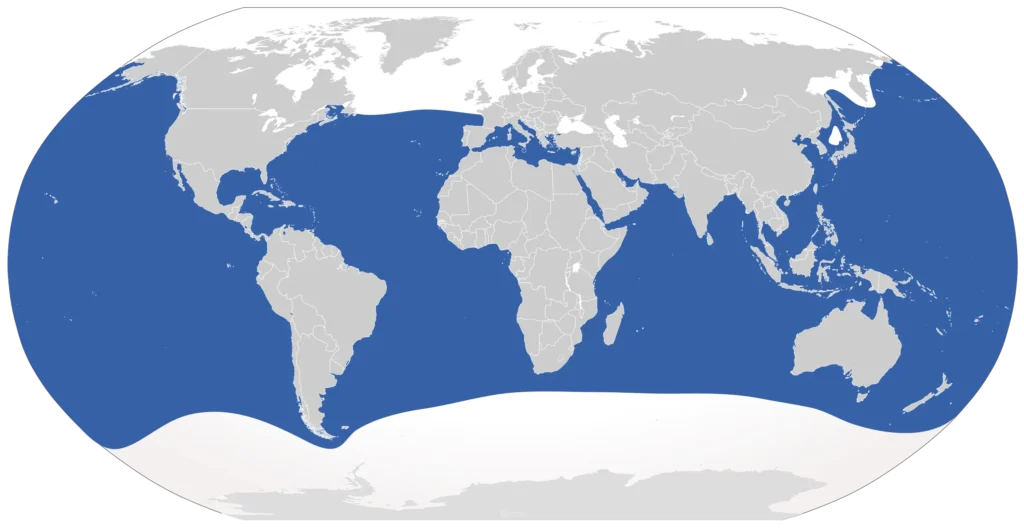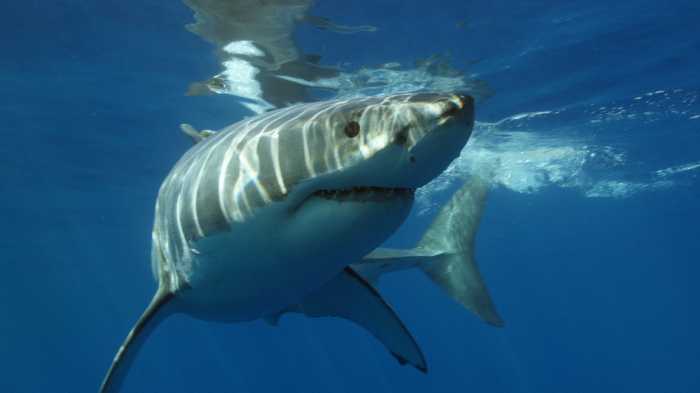Great White Shark (Carcharodon carcharias)- one of the most famous marine predators, causing both fear and admiration. It occupies the top of the food chain and has extremely advanced hunting skills. With a powerful body, sharp teeth and high intelligence, this shark is a true "master of the ocean".
In this article, we will look at Anatomy, behavior, habitat, food habits, reproduction, threats and role in nature. We will also dispel the myths that accompany this predator.

1. General characteristics and classification
The white shark belongs to the family neon sharks (Lamnidae), which also includes mako sharks and salmon sharks. It is the only modern representative of the genus Carcharodonhaving a common ancestor with an extinct megalodon.
🔹 Scientific classification:
✔ The Kingdom: Animals (Animalia)
✔ Type: Chordal (Chordata)
✔ Class: Cartilaginous fish (Chondrichthyes)
✔ Row: Lamnopodobnye (Lamniformes)
✔ Family: New products (Lamnidae)
✔ Gender: Carcharodon
✔ View: Carcharodon carcharias
🔹 Other names:
✔ Great white shark
✔ White Death
✔ Karcharodon
2. Appearance and features
The great white shark is one of the largest predatory fish in the world.
🔹 Main Features:
✔ Length: 4-6 meters (the record is 7 meters).
✔ Weight: 1-2 tons (the largest specimen is 2.5 tons).
✔ Body: streamlined, spindle-shaped, providing excellent maneuverability.
✔ Color scheme: blue-gray back and white belly are effective camouflage tactics.
✔ Jaws: contain 300 sharp teetharranged in 5-7 rows.
✔ Skin: covered with scalloped scales that reduce water resistance.
✔ Speed: to 56 km / h.
✔ Body temperature: the shark has the ability to retain heat, which gives it an advantage in cold waters.
🔹 White Shark Teeth:
✔ Form: triangular, jagged edges-ideal for tearing flesh.
✔ Regeneration: during life, the shark changes up to 50,000 teeth.

3. where does the great white shark live?
The white shark is a cosmopolitan species that inhabits almost all the world's oceans.
🌍 Distribution geography:
✔ Atlantic Ocean - coast of the USA, Canada, Europe, South Africa.
✔ Pacific ocean - California, Australia, New Zealand, Japan.
✔ Indian Ocean - coast of Africa, India, and Indonesia.
✔ The Mediterranean Sea - rare, but found near Italy and Greece.
🌊 Depth of living:
✔ Usually 0-200 m, but can be submerged up to 1200 m.
📍 Largest populations:
✔ Guadalupe Island (Mexico)
✔ South Africa
✔ Faralona Islands (California)
✔ Neptune Island (Australia)

4. eating habits
The white shark is an active hunter, preying on large prey.
🍴 What do great white sharks eat?
✔ Seals and sea lions
✔ Dolphins and other small cetaceans
✔ Sea turtles
✔ Other fish, particularly tuna
✔ The dead (carrion)
🏃♂️ How do they hunt?
✔ Use surprise attack effect.
✔ Attack from bottom to topdealing a crushing blow.
✔ Sometimes watch the prey before attacking.
🐬 Do people get attacked?
✔ Attacks are rare-the shark does not perceive humans as food.
✔ Most often, bites are "test" ones.
✔ In most cases, sharks do not continue their attack.
5. reproduction
The white shark belongs to ovoviviparous species.
🔹 Reproductive features:
✔ Puberty: males are 9-10 years old, females are 12-15 years old.
✔ Pregnancy: continues 12-18 months.
✔ Number of cubs: from 2 to 10.
✔ Cannibalism in the womb: stronger embryos can eat weaker ones.

6. threats and security
The population of white sharks is declining due to human activity.
⚠️ Main threats:
✔ Trapping for swimmers, teeth, and meat.
✔ Death in fishing nets.
✔ Ocean pollution.
✅ Security measures:
✔ Added to the IUCN Red List (a threatened species).
✔ Protected in the USA, South Africa, Australia, New Zealand.
✔ Marine reserves have been introduced.
7. Interesting facts about the white shark
✔ Super Sniffer: can sense a drop of blood at a distance of 1 km.
✔ Longevity: live up to 70 years old.
✔ Social behavior: can hunt in groups.
✔ HypnosisQuestioner: if you turn a shark on its back, it goes into a state of stupor.
✔ The bite: bite force – 1.8 tons / cm2which is 20 times stronger than that of a human.
Conclusion
The great white shark is one of the ocean's greatest predatorswhich plays an important role in the marine ecosystem. She is not a ruthless killer, as often portrayed in films, but rather an intelligent and efficient creature who needs protection from human activity. 🦈🌊